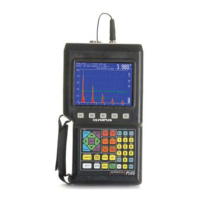166
EPOCH 4PLUS
Beam Index Point The point on the base of an angle beam probe’s wedge
from which the sound leaves the wedge and enters the
specimen.
Cal Block Velocity Material sound velocity for the calibration block.
Couplant A material (usually a liquid or gel) used between the
transducer and the test specimen to eliminate air from
this space and thus facilitate the passage of sound
waves into and out of the specimen.
Critical Defect Either the largest tolerable defect or the smallest
intolerable defect. The critical defect size is usually
given by a specification or code.
Cross Talk An unwanted condition affecting dual element
transducers in which acoustic energy travels from the
transmitting crystal to the receiving crystal by routes
other than the intended path through the material.
Damping (Control) A variable resistance across the pulser circuit output
which shapes the excitation pulse. Typically it is used
to change pulse characteristics to optimize either
penetration (low damping) or near surface resolution
(high damping).
Note: High damping = Low damping ohms (50 Ω)
Low damping = High damping ohms (400 Ω)
Damping Material Any gel, rubber-like substance, or other material
which, when used in the transducer, results in a shorter
ringing time of the piezoelectric crystal.
Decibel (dB) A unit which compares levels of power. Two power
levels P1 and P2, are said to differ by n decibels when:
n = 10 log
10
This unit is often used to express sound intensities. In
this case, P2 is the intensity of the sound under
consideration and P1 is the intensity of some reference
level.
In the case of the displayed voltages on a cathode ray
tube screen, the relationship becomes:
n = 20 log
10
Delay Control Subcircuit of the sweep generator that allows a
variably adjustable time period from the sending of the
trigger pulse to the start of the sweep across the CRT.
Term Definition
P
2
P
1
------
V
2
V
1
------

